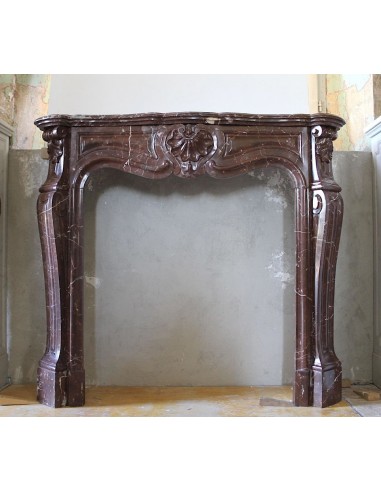For you to better understand the peculiarities of this fire surround, we must take a step back, enter the history of the most beautiful “house” in the world, the Palace of Versailles.
In short, we must go back to 1663, the year when work began on this fantastic property, destined to commemorate the Bourbon family until the year of Judgment.
So many were the architects of Versailles, both because of the amount of work that such a building demanded and because its construction lasted a good twenty years round and round.
But ..among the many architects the most important was.... Louis XIV!!!
He put his beak into any decision, and since in the field of fireplaces he was what you would call “a maniac,” once the design of a certain fireplace was approved, it was on to the choice of the relevant marble in which to carve it, a choice to which the imprimatur of the King Architect was needed..
Do you know how many fireplaces he placed his choices on?
The lowest estimate speaks of 1552 mantels!!!
When I think of this unbelievable number of fireplaces, I always think of the one who, in charge of lighting them, was heard apostrophizing the Sun King... “Come on, Henry, it's freezing tonight, go light ALL the marble fireplaces and make it quick because if I get chilblains I'll have you guillotined!!!
But back to our Sun King and the time when he had to choose the marbles for his mantels....
As part of the fireplaces that were to be red in color, he chose two marbles in particular:
“ROUGE GRIOTTE“ (its name has an Italian root, the word Agriotta,” a word by which black cherry was anciently called. How did this marble from beyond the Alps come to be called by an Italian name? Well, you have to know that almost all so-called “French” fireplaces are French in style, but not in sculpture work which was-FORTUNATELY-Italian and so, the much commonality with Italian master sculptors often led to these intermingling of language and names) and “ROUGE FRANCE,” that was the original name of the marble in our fireplace.
Over time, then, while the Rouge Griotte remained, shall we say, “at the post,” our Rouge France took the appellation first of “Rouge Royal” and then finally became “Rouge Royal Versailles.”
I will conclude this Versaillian chronicle by saying that, besides our “Rouge France,” only one other marble chosen by Louis XIV for his palace, the fantastic and perhaps miraculous (it was quarried 4 km from the grotto of Lourdes) Sarrancolin took the appellation “Sarrancolin Versailles.”
It is obvious that we can never know what so fascinated the Sun King as to appell our marble initially with the mark “Royal” and then even with the added nickname of “Versailles,” we can only speculate, express our ideas and considerations...
This is how I see it:
Meanwhile its color, not really “red” but that red has it in it, deep inside, in its mysterious innards.... I called him an “Antique Red,” a red that has nothing to do with his many marble brethren defined as red in color, it is as if he came, ours, from another planet.
Then the fact of its very white, subtle, delicate, not at all intrusive, very elegant and discreet fretting.
HOWEVER, ONE THING IS CERTAIN: “SOME ELEMENT HAS IT, THIS MARBLE, OF MYSTERY AND FASCINATION,” AND EVEN IF WE CAN'T GET THE PRECISE FORMULA, WE CAN STILL ENJOY ITS EFFECTS.
I forgot: The Sun King was not the only one who fell in love with this marble, even the most important architect of Art Nouveau, the legendary Louis Majorelle, designed and built in his Maison Majorelle (in Nancy) fireplaces in this marble, taking care that the quarrying of the marble took place in the same quarry from which the Rouge Royal Versailles was extracted, in its time!!! On display in our exhibition is just such a fireplace designed and made by Majorelle carved from solid marble from this same royal quarry.
Does it seem strange to you that a person could fall in love (and how much!!) with a marble?
Well, then I'll tell you that our own Cosimo de Medici (MAYBE THE GREATEST MECENATE IN HISTORY) fell so much in love with a Statuario Venato marble from Serravezza that he... HE COMMANDED ITS QUARRY!!! THIS MARBLE HAS SINCE TAKEN THE NAME “MEDICEAN BRECCIA.”
I HOPE I HAVE NOT BORED YOU, BUT YOU WILL AGREE WITH ME THAT THESE STORIES HAVE THEIR IMPORTANCE FOR THE UNDERSTANDING OF OUR MANTEL, WHICH, ALTHOUGH “ONLY” NINETEENTH-CENTURY (NAPOLEON III PERIOD, TO READ THE NOTE AT THE BOTTOM OF THE PAGE ***) BRINGS IN DOWRY A PROVEN ANCIENT NOBILITY.
ITS MODEL IS A CLASSIC “TROIS COQUILLES,” OF VERY HEALTHY AND STURDY CONSTITUTION (IT WAS CARVED IN SLABS OF IMPORTANT THICKNESS), PERFECTLY PRESERVED AND BY US ONLY CLEANED AND WAXED, IN SHORT, WE HAVE ONLY EMBELLISHED IT, THE REST WAS DONE BY THE PREVIOUS OWNERS.
ITS PROVENANCE IS PARISIAN.
*** Napoleon III, who was he?!
I consider the genius of antiquarians to be a human race unto itself, mostly composed of people dedicated to their work with a passion that is rare to find in other categories of workers. Yet very often I find myself “badmouthing” antiquarians, and always for one reason only: their presumption to know everything, their irrepressible need to express opinions even about things of which they are more or less ignorant. I sell antique fireplaces, always have, and of antique furniture nothing I understand, which is why, if I am asked to express opinions about an eighteenth-century console table, I respond with a “I'm sorry, I'm not competent in the matter..” On the contrary, if an antiquarian is asked for an opinion on an antique fireplace, except in very rare cases of acute modesty, he delves into magniloquent rants dictating rules and certainties with very weak, if any, foundations.
Thus engendering in the listener (who trusts him like the ancients trust the oracle of Delphi, otherwise he wouldn't have asked him for an opinion, would he?!..) false ideas and false prejudices. Now, you should know that when an antiquarian hears about artifacts (and artifacts include fireplaces..) from the “Napoleon III” era (second half of the 19th century) he seems to be seized by St. Anthony's Fire, his face turns into a disgusted grin and his mouth becomes a denial factory.
But you should also know that, if anything, the furniture of that period is to be considered of low quality and stylistic weight (which I do not know and do not presume to assert...), it is also true that the most beautiful fireplaces in history were made in that same period, both in terms of their stylistic weight and the quality and technique of their sculptural workmanship.
Now, true to the motto “Carta canta, villan dorme,” I would like to ask you whether or not the fireplace I am showing you here is a “piece” of undoubted beauty.
You tell me whether or not this is not a stylistically interesting fireplace, rich in decorative load, certainly capable of entering into any furnishing situation by virtue of an apt and mature stylism.
And, please tell your antique dealer as well!
























































